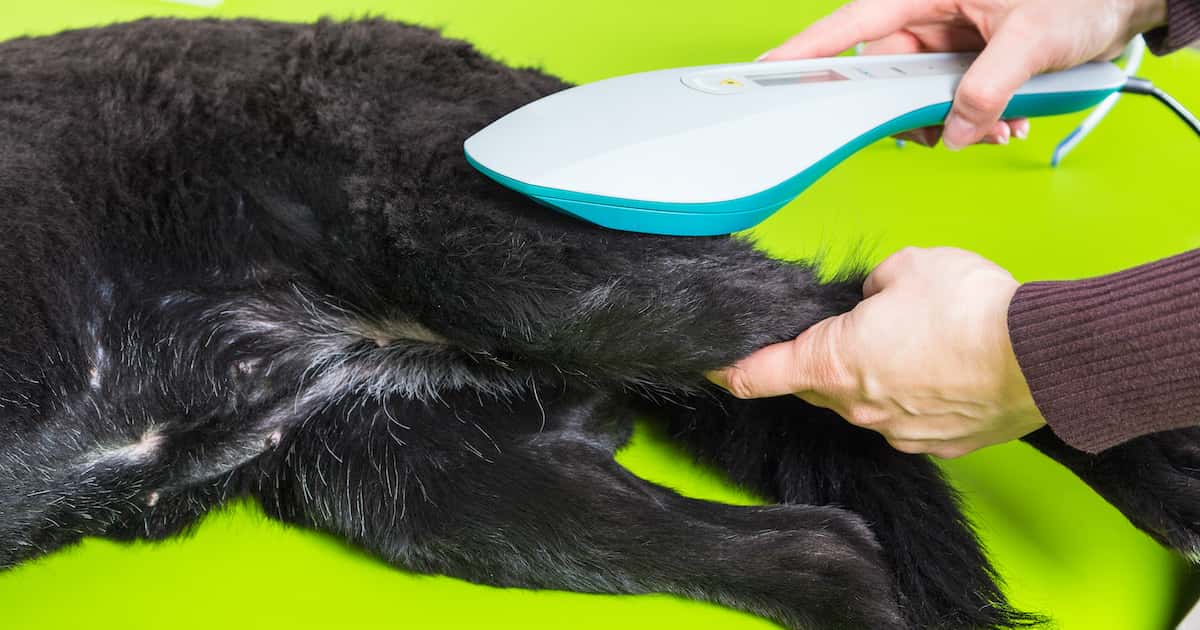Home>Health & Wellness>Common Health Issues>Muscular and Joint Health>What Does Laser Do For Arthritis In Dogs?


Muscular and Joint Health
What Does Laser Do For Arthritis In Dogs?
Modified: February 21, 2024
Improve your dog's muscular and joint health with laser therapy for arthritis. Discover the benefits of this non-invasive treatment option today.
(Many of the links in this article redirect to a specific reviewed product. Your purchase of these products through affiliate links helps to generate commission for Pawsomeoldies.com, at no extra cost. Learn more)
Table of Contents
Introduction
Arthritis is a common condition that affects dogs of all ages, causing pain, stiffness, and reduced mobility. As a pet owner, witnessing your furry companion struggle with arthritis can be distressing. Fortunately, advancements in veterinary medicine have led to the development of innovative treatments, including laser therapy, which has shown promising results in alleviating the symptoms of arthritis in dogs.
Laser therapy, also known as photobiomodulation, involves the use of specific wavelengths of light to stimulate cellular processes and promote healing. This non-invasive and painless treatment has gained popularity in the veterinary field for its ability to target inflamed joints and provide relief for dogs suffering from arthritis.
In this article, we will delve into the intricacies of arthritis in dogs, explore how laser therapy works as a treatment modality, and discuss the potential benefits and considerations associated with this approach. By gaining a deeper understanding of laser therapy for arthritis in dogs, you can make informed decisions about the well-being of your canine companion and explore viable options for managing their condition effectively.
Understanding Arthritis in Dogs
Arthritis, a term derived from the Greek words "arthro," meaning joint, and "itis," indicating inflammation, is a prevalent condition that affects dogs, particularly as they age. This degenerative joint disease can also manifest in younger dogs due to genetic predispositions, joint trauma, or developmental issues. Arthritis in dogs encompasses a spectrum of joint-related ailments, including osteoarthritis, rheumatoid arthritis, and septic arthritis, each presenting its own set of challenges.
The hallmark of arthritis in dogs is the progressive deterioration of joint cartilage, leading to pain, stiffness, and reduced mobility. As the protective cartilage wears away, the bones within the joint may rub against each other, causing discomfort and inflammation. This can result in a diminished quality of life for the affected dog, impacting their ability to engage in physical activities and diminishing their overall well-being.
Common symptoms of arthritis in dogs include reluctance to engage in physical activities, limping, difficulty rising from a resting position, and behavioral changes such as irritability or withdrawal. Additionally, dogs with arthritis may exhibit signs of discomfort when their joints are touched or manipulated. It's essential for pet owners to remain vigilant and attentive to these subtle cues, as early detection and intervention can significantly improve the prognosis for dogs with arthritis.
Arthritis can affect any joint in a dog's body, with the most commonly impacted areas being the hips, knees, elbows, and spine. Large and giant breeds are particularly susceptible to arthritis due to their size and weight, which places increased stress on their joints. Furthermore, certain factors such as obesity, poor nutrition, and inadequate exercise can exacerbate the development and progression of arthritis in dogs.
Understanding the multifaceted nature of arthritis in dogs is crucial for implementing effective management strategies. By recognizing the signs and symptoms of arthritis and comprehending its impact on a dog's well-being, pet owners can proactively seek out appropriate treatments to alleviate their furry companion's discomfort and enhance their quality of life.
How Laser Therapy Works
Laser therapy, also known as photobiomodulation, operates on the principle of utilizing specific wavelengths of light to stimulate cellular processes within the body. When applied to the affected areas, the photons emitted by the laser penetrate the skin and are absorbed by the underlying tissues. This interaction triggers a series of biological responses at the cellular level, leading to a cascade of therapeutic effects.
At the core of laser therapy's mechanism is its ability to enhance cellular metabolism. The photons absorbed by the cells stimulate the production of adenosine triphosphate (ATP), the energy currency of the cell. This surge in ATP production fuels cellular activities, including the repair and regeneration of damaged tissues. Additionally, laser therapy promotes vasodilation, which widens the blood vessels and improves blood flow to the targeted area. This heightened circulation facilitates the delivery of oxygen and nutrients to the tissues, accelerating the healing process.
Furthermore, laser therapy modulates the inflammatory response within the body. By reducing the production of pro-inflammatory mediators and cytokines, it helps to mitigate swelling and pain associated with arthritis. The treatment also stimulates the release of endorphins, natural pain-relieving compounds, providing relief for the dog and improving their overall comfort.
The therapeutic effects of laser therapy extend beyond the cellular level, influencing nerve conduction and the release of neurotransmitters. This can lead to a reduction in nerve sensitivity, alleviating pain signals and enhancing the dog's tolerance to discomfort.
It is important to note that laser therapy is a non-invasive and painless procedure, making it well-tolerated by dogs. The treatment sessions are typically brief, ranging from a few minutes to half an hour, depending on the size of the treatment area and the severity of the condition. The number of sessions required may vary based on the individual dog's response to the therapy and the recommendations of the veterinary professional overseeing the treatment.
By harnessing the power of light at specific wavelengths, laser therapy offers a holistic approach to managing arthritis in dogs. Its ability to stimulate cellular metabolism, improve circulation, modulate inflammation, and alleviate pain makes it a valuable adjunct to conventional treatment modalities. As pet owners seek comprehensive solutions to enhance their dog's well-being, laser therapy stands out as a promising avenue for addressing the challenges posed by arthritis.
Benefits of Laser Therapy for Arthritis in Dogs
Laser therapy offers a myriad of benefits for dogs suffering from arthritis, providing a non-invasive and drug-free approach to managing their condition. The therapeutic effects of laser therapy extend beyond mere symptom relief, encompassing a holistic approach to promoting healing and enhancing the overall well-being of affected dogs.
1. Pain Management
Laser therapy effectively mitigates pain associated with arthritis in dogs. By modulating the inflammatory response and stimulating the release of endorphins, natural pain-relieving compounds, it offers a gentle yet potent method of alleviating discomfort. This enables dogs to experience improved mobility and engage in physical activities with reduced hindrance, contributing to their overall quality of life.
2. Enhanced Mobility
The reduction of pain and inflammation through laser therapy contributes to enhanced mobility for dogs with arthritis. By targeting the affected joints and tissues, the treatment promotes the repair and regeneration of damaged cells, facilitating improved joint function and flexibility. This, in turn, enables dogs to move more comfortably and actively participate in daily activities, fostering a sense of vitality and well-being.
3. Accelerated Healing
Laser therapy accelerates the healing process for dogs with arthritis by enhancing cellular metabolism and promoting tissue repair. The heightened production of ATP and improved circulation facilitated by the treatment expedite the restoration of damaged tissues, leading to a more rapid recovery and improved joint health. This can significantly reduce the duration of discomfort and disability experienced by affected dogs, allowing them to regain their vitality sooner.
4. Non-Invasive Nature
One of the key advantages of laser therapy is its non-invasive nature. Unlike surgical interventions or pharmaceutical treatments, laser therapy does not require incisions or the administration of medications, minimizing the risk of adverse effects and post-treatment complications. This makes it a safe and well-tolerated option for dogs, particularly those with sensitivities to certain medications or anesthesia.
5. Complementary to Conventional Treatments
Laser therapy serves as a valuable complementary treatment to conventional modalities for managing arthritis in dogs. When used in conjunction with medications, physical therapy, and lifestyle modifications, it can enhance the overall efficacy of the treatment regimen. This integrative approach addresses the multifaceted nature of arthritis, offering a comprehensive strategy for improving the well-being of affected dogs.
In summary, laser therapy presents a host of benefits for dogs grappling with arthritis, encompassing pain management, enhanced mobility, accelerated healing, non-invasiveness, and complementarity to conventional treatments. By harnessing the therapeutic potential of light, pet owners can explore a holistic and effective avenue for alleviating the challenges posed by arthritis in their beloved canine companions.
Read more: What Does Arthritis Look Like In A Dog?
Risks and Considerations
While laser therapy offers a host of benefits for dogs with arthritis, it is essential for pet owners to consider certain risks and factors before pursuing this treatment modality. Understanding the potential drawbacks and considerations associated with laser therapy can empower pet owners to make informed decisions regarding the well-being of their canine companions.
1. Eye Protection
During laser therapy sessions, it is crucial to shield the dog's eyes from direct exposure to the laser beam. The intense light emitted during the treatment can pose a risk to the eyes, potentially causing damage if proper precautions are not taken. Veterinary professionals administering laser therapy employ specialized eye protection for both the dog and the attending personnel, ensuring the safety of all involved.
2. Tumor Growth
In some cases, laser therapy may not be suitable for dogs with existing tumors or cancerous growths. The stimulation of cellular processes and increased blood flow associated with laser therapy could potentially exacerbate the growth of tumors. Therefore, it is imperative for veterinary professionals to conduct a thorough assessment of the dog's medical history and current health status to determine the appropriateness of laser therapy as a treatment option.
3. Overheating
Prolonged exposure to the laser's thermal effects can lead to overheating of the tissues, potentially causing discomfort or adverse reactions in the treated area. Veterinary professionals carefully monitor the duration and intensity of laser therapy sessions to prevent overheating and ensure the safety and well-being of the dog undergoing treatment.
Read more: What To Do For Dog’s Hip Arthritis
4. Treatment Response
While many dogs experience positive outcomes from laser therapy, individual responses to the treatment may vary. Factors such as the severity of the arthritis, the dog's overall health, and their responsiveness to the therapy can influence the efficacy of laser treatment. It is important for pet owners to maintain realistic expectations and engage in open communication with the veterinary team to assess the dog's progress and make informed decisions regarding the continuation of laser therapy.
5. Cost Considerations
Pet owners should also consider the financial implications of laser therapy as a treatment modality for arthritis in dogs. The cost of multiple therapy sessions, coupled with any additional veterinary consultations and assessments, should be factored into the overall management plan for the dog's arthritis. Open discussions with the veterinary team can provide clarity on the anticipated costs and help pet owners make informed choices aligned with their budget and the well-being of their furry companions.
By acknowledging these risks and considerations, pet owners can approach laser therapy for arthritis in dogs with a comprehensive understanding of the potential implications and safety measures. Open communication with veterinary professionals, adherence to safety protocols, and a proactive approach to monitoring the dog's response to treatment can collectively contribute to a positive and well-informed experience with laser therapy as a part of the holistic management of arthritis in dogs.
Conclusion
In conclusion, laser therapy stands as a promising and multifaceted approach to managing arthritis in dogs, offering a non-invasive, drug-free, and holistic method of addressing the challenges posed by this prevalent condition. By harnessing the therapeutic potential of specific wavelengths of light, laser therapy effectively targets inflamed joints, mitigates pain, and promotes the healing and regeneration of damaged tissues. The benefits of laser therapy extend beyond mere symptom relief, encompassing enhanced mobility, accelerated healing, and a complementary role in the overall treatment regimen for dogs with arthritis.
The understanding of arthritis in dogs as a multifaceted condition, coupled with the intricate workings of laser therapy in stimulating cellular processes and modulating inflammation, underscores the significance of this treatment modality in the veterinary landscape. Laser therapy offers a gentle yet potent means of alleviating the discomfort experienced by dogs with arthritis, enabling them to regain their vitality and engage in daily activities with renewed vigor.
However, it is essential for pet owners to approach laser therapy with a comprehensive understanding of the associated risks and considerations, including the need for eye protection, the potential impact on tumor growth, and the importance of monitoring the dog's response to treatment. By collaborating closely with veterinary professionals and maintaining open communication, pet owners can navigate these considerations effectively and ensure the safety and well-being of their furry companions throughout the course of laser therapy.
As advancements in veterinary medicine continue to evolve, laser therapy emerges as a valuable tool in the management of arthritis in dogs, offering a blend of innovation, efficacy, and compassion. By embracing this non-invasive and well-tolerated treatment modality, pet owners can embark on a journey toward enhancing the quality of life for their beloved canine companions, fostering a sense of vitality and well-being that transcends the limitations imposed by arthritis.
In essence, laser therapy for arthritis in dogs represents a beacon of hope, illuminating a path toward alleviating pain, restoring mobility, and nurturing the overall well-being of dogs grappling with this challenging condition. Through informed decision-making, proactive engagement with veterinary professionals, and a steadfast commitment to the welfare of their furry companions, pet owners can embark on a transformative journey with laser therapy, empowering their dogs to embrace life with renewed comfort and vitality.












